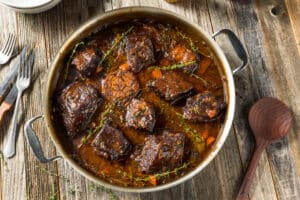Braising vs. Roasting: What’s the Difference?
Braising and roasting are two popular cooking methods that bring out the flavors in meats, but each technique has its unique approach, moisture level, and best uses. Understanding the differences between braising vs. roasting will help you decide when to braise and when to roast for the best results.
What is Braising?

Braising is a slow-cooking method combining dry and moist heat to produce very tender, juicy meat that often falls apart. The process begins by searing the meat at a high temperature to develop a flavorful crust, then simmering it in a covered pot with a small amount of liquid such as broth, wine, or stock. This technique relies on high moisture content, with the meat partially submerged in the liquid throughout the cooking process. Braising typically occurs at a lower temperature, usually between 275°F and 300°F, and is ideal for tougher cuts of meat, such as chuck roast, brisket, short ribs, lamb shanks, or pork shoulder. These cuts benefit from the long, slow cooking time that allows the collagen in the connective tissue to break down. This results in a tender, flavorful meat. The texture of braised dishes is incredibly soft and juicy, often falling apart with ease. Braising is ideal for hearty dishes like stews, pot roasts, and short ribs, requiring moisture retention and deep flavor.
What is Roasting?
Roasting is a dry-heat cooking method that focuses on creating a crisp, caramelized exterior while keeping the inside of the meat tender and juicy. Unlike braising, roasting involves cooking food uncovered in the oven, allowing the surface to brown and form a crust. Little to no additional moisture is involved in the process, making it all about enhancing the meat’s natural flavors and creating that desirable crisp texture. Roasting generally takes place at higher temperatures, ranging from 325°F to 450°F. It’s ideal for tender cuts like beef tenderloin, pork loin, whole chicken, or leg of lamb. These cuts don’t require long cooking times to become tender, allowing them to develop a crispy exterior while retaining their juicy interior. Roasting is ideal for whole poultry, prime rib, or even vegetables that benefit from a flavorful, caramelized surface.
When to Choose Braising
Braising is the best choice when working with tougher cuts of meat that require low and slow cooking to break down fibers and create melt-in-your-mouth tenderness. This method excels at developing rich, deep flavors, as the slow cooking process allows the meat to soak up the flavors from the liquid, aromatics, and spices. Braised dishes are not just hearty and comforting, they bring a sense of warmth and coziness, perfect for colder weather.
When to Choose Roasting
Roasting is a better option to achieve a crisp, caramelized texture on the outside while keeping the meat tender inside. It’s perfect for cuts that don’t need prolonged cooking times to become tender and benefit from a quicker, higher-temperature cook. Roasting is ideal when you want to enjoy crisp textures or need to prepare a meal in less time. It’s a method that makes you feel efficient and productive in the kitchen.
Braising vs. Roasting: The Verdict

Veal Osso Buco
Braising is ideal for creating rich, moist dishes that require slow cooking. Roasting is perfect for achieving a crisp exterior with tender meat inside in a shorter amount of time. Both techniques offer flavorful results. Their versatility empowers you to be creative in the kitchen, depending on the type of dish you’re aiming to create.
Visit The Art of Braising to learn more about braising and follow us on Instagram!
#BraiseWithTonys

